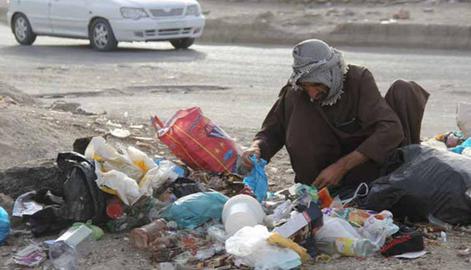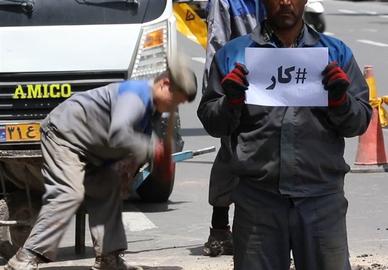The term “misery index,” or economic suffering, may remind many Iranians of candidates’ debates in the campaign for the 2009 presidential election. One of the candidates, Major General Mohsen Rezaee, had yet to capture much attention, and when he launched his campaign as an economist, many were surprised. Nobody asked him where and when he had studied economics — or indeed how a controversial wartime Revolutionary Guards commander had emerged from his tours of duty with such a grasp of fiscal and monetary policies.
But Rezaee was perhaps the first prominent figure in the Islamic Republic to speak of a misery index in public. On June 8, 2009, during his last presidential debate with the incumbent Mahmoud Ahmadinejad, Rezaee pointed at a chart of the so-called misery index and said: “This indicator moves up on a steep curve, from the summer of 2006 to the fall of 2009,” clearly referring to Ahmadinejad’s term as president. It is not known who gave this chart to Rezaee but, whoever it was, the individual must have been versed in economics and the history of presidential campaigns in the United States. During the 1976 US presidential campaign, candidate Jimmy Carter popularized the misery index as a means of criticizing his opponent, the incumbent Gerald Ford. Carter made many references to this index which, at that time, had reached 14 percent. Later, during Carter’s own term as president, the indicator flew past 20 percent and he lost the presidency to Ronald Reagan and his “Morning in America” message in 1980.
Rezaee was not talking nonsense during that 2009 debate. Statistics did show that the index was rising in Iran — it had reached as high as 36 percent. But neither this number, nor its steep rise during Ahmadinejad’s first term, were unprecedented in Iran’s economic history; nor was the index’s rise significant compared to what was to come in the following years.
What is the Misery index?
The misery index is an indicator that was first created in the 1970s by the economist Arthur Okun, who served as the second chairman of President Lyndon B. Johnson’s Council of Economic Advisors and who was an economics professor at Yale. Okun’s index used the simple sum of the nation’s annual inflation rate and unemployment rate to provide President Johnson with an easily-understood snapshot of the economy’s relative health.
Later economists made changes to how this index was calculated, having decided that the simple addition of inflation and unemployment rates distort a true picture of the nation’s economic wellbeing. In 1999, the Harvard economist Robert Barro changed the index to include both the interest rate and economic growth data. He argued that the pressures of unemployment and inflation are different during economic booms and busts. A prosperous economy can more easily tolerate an inflation rate of 30 percent and an unemployment rate of 12 percent than when an economy is in negative growth rate.
After Barro, other economists created yet more versions of the index by including indicators such as bank lending rates, increases or decreases in houses prices, and so on.
Fluctuations in Iran’s Misery Index
Iran’s misery index, like any economic indicator, fluctuates over time. But in the last 30 years this index has never fallen below 21 percent and in at least five years — 1994, 1995, 2013, 2018 and 2019 — it has shot above 40 percent. The first two occasions of this were a result of the inflation crisis during the second term of Hashemi Rafsanjani’s presidency, which led to street protests and the suppression of these protests. The third one, in 2013, happened during the last year of Mahmoud Ahmadinejad’s presidency. The fifth and the sixth occasions, of course, coincide with the current crisis in the Iranian economy.
To understand what a misery index of 40 percent means in real terms, it is enough to know that in 2019 only three economies, including Iran, had a misery index of over 40 percent and in only eight countries was this indicator higher than 30. Iran’s competition for the most “miserable” economy in 2019 were Venezuela, Zimbabwe and Argentina, three countries experiencing among the most intense mixes of political and economic crisis in the world today.
And while it may seem that former president Rafsanjani’s second administration set the record for Iran’s own misery index, if the recent economic recession is included then the 1995 record was broken in 2019, when the misery index passed 59 percent and nearly hit an appalling level of 60 percent. In 1995 the rate of economic growth in Iran was +2.3 percent while, according to the International Monetary Fund (IMF), in 2019, Iran’s growth turned negative, falling as low as -9.5 percent, illustrating the depth of the economic and social crisis.
Related Coverage:
Iran’s Shrinking Economy, October 21, 2019
Iran Joins Eurasian Economic Union to Combat US Sanctions, October 14, 2019
Employment Figures for Summer 2019: Has it Really Improved?, October 11, 2019
Is There any Hope of Reining in Iran's Runaway Inflation?, May 24, 2019
This Year 57 Million Iranians Will Be Living Below the Poverty Line, May 15, 2019
A Bleak Future for Iran's Job Market, May 3, 2019
Decline in Investment Across Iran After US Exit from the Nuclear Deal, April 27, 2019
Can Iran Survive Record Inflation?, February 25, 2019
Iran’s Unemployment Crisis: Only 11 Million Full-time Jobs, January 23, 2019
visit the accountability section
In this section of Iran Wire, you can contact the officials and launch your campaign for various problems

























comments